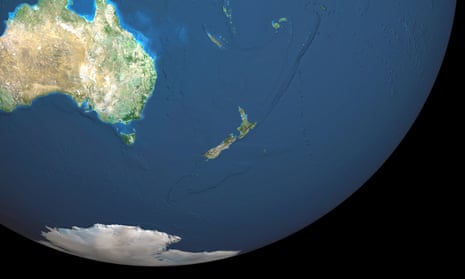Scientists have found evidence that Earth was covered by a global ocean that turned the planet into a “water world” more than 3bn years ago.
Telltale chemical signatures were spotted in an ancient chunk of ocean crust which point to a planet once devoid of continents, the largest landmasses on Earth.
If the findings are confirmed by future work, they will help researchers to refine their theories on where and how the first single-celled life emerged on Earth, and what other worlds may be habitable.
“An early Earth without emergent continents may have resembled a ‘water world’, providing an important environmental constraint on the origin and evolution of life on Earth, as well as its possible existence elsewhere,” the scientists write in Nature Geoscience.
Boswell Wing, of the University of Colorado, Boulder, and his former postdoctoral student Benjamin Johnson, now at Iowa State University, launched the project to break fresh ground in the debate over what ancient Earth might have looked like.
Their work centred on a geological site called the Panorama district in north-western Australia’s outback, where a 3.2bn-year-old slab of ocean floor has been turned on its side. Locked inside the ancient crust are chemical clues about the seawater that covered Earth at the time.
The scientists focused on different types of oxygen that seawater had carried into the crust. In particular, they analysed the relative amounts of two isotopes, oxygen-16 and the ever-so-slightly-heavier oxygen-18, in more than 100 samples of the stone.
They found that seawater contained more oxygen-18 when the crust was formed 3.2bn years ago. The most likely explanation, they believe, is that Earth had no continents at the time, because when these form, the clays they contain absorb the ocean’s heavy oxygen isotopes.
“Without continents above the ocean, the oxygen value would be distinct from today, which is exactly what we found,” Johnson said. “And it’s different in a way that’s most easily explained without land to get rained on and without soil formation.”
The findings do not mean Earth was entirely landless at the time. The scientists suspect that small “microcontinents” may have poked out of the ocean here and there. But they do not think the planet hosted vast soil-rich continents like those that dominate Earth today.
“I imagine a picture kind of like what it must look like to approach the Galápagos Islands from the west: vast expanses of ocean waters to the north and south with small volcanic rocky islets barely poking above the ocean surface,” said Wing.
Other explanations are possible, the researchers note. The same chemical signature could arise if continents formed far slower in the deep past than they do today, or if the continental clays that absorb heavy oxygen isotopes formed in the sea rather than on land.
It remains a mystery when the first continents eventually formed, most likely through the gradual slowing of heat loss from the Earth’s interior. But about half a billion years ago, Earth was dominated by the supercontinent Gondwana, which lasted into the Jurassic period, about 180m years ago. Wing now plans to look at oxygen isotope ratios in younger oceanic crust in the hope of nailing down when the global continents emerged.
“The oldest preserved continental material is approximately 4bn years old and the subsequent growth and emergence of the continental landmasses is constantly debated,” said Alan Hastie, an igneous petrologist at the University of Birmingham.
“Earth scientists use a variety of methods to try to estimate how the volume of the continents has changed over time. This is important as the volcanism associated with continental growth and the erosion of landmasses has modified the composition of Earth’s oceans and atmosphere. Therefore, any new study to help us constrain the amount of continental emergence is welcome,” he added.
